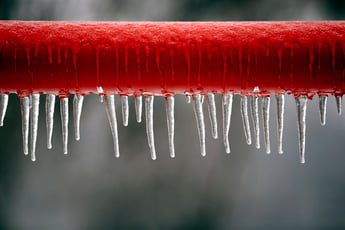
For most of the country, winter is here, and it won’t be leaving anytime soon. During these times, it’s important to ensure your fire protection systems and equipment are ready to withstand and handle what the winter season brings your way.
Your building’s sprinkler system is an essential part of your business. It’s a necessary system for the health and safety of your employees and your property. Pipes are known to freeze in colder temperatures, but have you considered that your fire sprinkler system can have the same issues? Now you may be asking, "What can I do to keep the sprinkler system from freezing?" Whether you have a wet or dry sprinkler, it's important you take the necessary precautions so they don't freeze.
Locations Throughout Building
Regardless of the type of sprinkler you have, the four most common areas within a building where a freeze is more likely to occur are fire sprinkler control rooms, isolated areas, mechanical rooms, and unoccupied spaces. It’s important to give extra time to inspect these areas prior to the winter months. You want to verify that these areas in the building, and the building in general, will maintain a temperature of 40°F so the water in the pipes don’t freeze.
If your sprinkler system’s piping runs through any of those areas mentioned above, you’ll also want to keep the doors and any air vents open to ensure warm air is circulating around the pipes.
You’ll want to verify that the fire department connection (FDC) is not full of water and ball drips are properly working. This is critical not only for you, your building, and employees, but also for the fire department in the event of an emergency. The water can become trapped between the FDC check valve and the sprinkler system and freeze; thus, limiting water flow to firefighters during a fire. This can be alleviated with routine maintenance and care by your preferred fire protection company. The FDCs are not intended to deliver a specific volume of water. Their purpose is to supplement the water supply, not provide the sprinkler’s demand.
Routine Checks for Wet or Dry Systems
Now that you’ve checked locations throughout your building - introduced above - and verified the FDC connection isn’t full of water, there are some routine checks you should complete to identify any vulnerabilities and guard against a freeze.
- Inspect and test all heating units, thermostats, breakers, and other related items to ensure they are property functioning.
- Check water storage tank heaters for proper operation.
- Inspect the integrity of pipe insulation.
If you notice any of the vulnerabilities listed above, it’s vital that you contact your preferred fire protection provider so they can begin to rectify these ahead of any issues.
Dry Fire Sprinkler Systems
Dry fire sprinkler systems aren’t only located in buildings. Mezzanines and garden areas have them, too. These fire sprinkler systems are designed with low points, where condensation collects. These need to be drained and winterized every fall by a licensed fire and life safety company to ensure no overflow, moisture, breaks, or freeze.
Anti-Freeze in Sprinkler Systems
While it would be nice for all buildings in regions with freezing temperatures to have dry fire sprinkler systems, that’s not the case. Like most pipes and equipment, many wet sprinkler systems add anti-freeze solution to prevent pipes from freezing. You’ll want to check the anti-freeze systems by testing the concentration of the anti-freeze solution. If using anti-freeze, you’ll want to do so in accordance with provisions in NFPA 13D for residential fire sprinkler systems and NFPA 13 for commercial fire sprinkler systems.
Winter has arrived and it is critical that your fire sprinkler system is well-maintained and prepared for the freezing temperatures. Routine maintenance can take care of any worry throughout the winter months and lower any risk of an issue arising.
For more on winterizing your fire sprinkler system and inspections, view the National Fire Protection Association (NFPA) standard NFPA 25.

